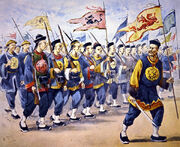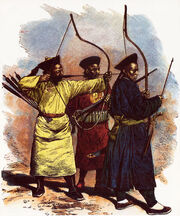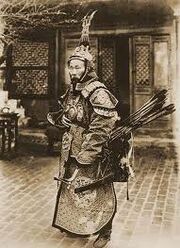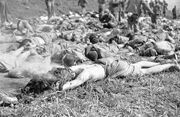The Great Revolution was a civil war fought in Qing China from 1893 to 1896 between Lee Weng, and later Wu Weng, and Chan Le. The Imperial Army at first was able to win spectacular victories against the rebels, but after the decisive Battle of Fuzhou, Lee's army begun losing battle after battle. After the Lee's defeat in Jinan, Lee was arrested and it was his nephew, Wu Weng, who took command of the forces loyal to the Lee faction. The war ended with a total defeat for Lee and his faction.
Origins[]

The rebel army.
Lee's reforms in the army, the economy, his arrest of corrupted officials and his diplomatic approach towards the Western Powers made many officials and military commanders enemies of Lee. Also, many of the people, especially the uneducated peasants, were against Lee because of his reforms. All those factors made sure that a new revolt would begin. The only thing missing was a charismatic leader to lead the revolt. But this was soon changed, as Chan Le became leader of the traditionalist faction. Chan, 69 years old and governor of the Anhui province, was a respected man, who had fought in the Taiping Rebellion under the command of Ma.
So, in 10 November 1893, Chan Le declared the young boy - brother of Guangxu Puyi Emperor of China and called the army to revolt against the usurper. Soon, the provinces of Anhui, Hubei, Hunan, Fujian, Jiangsu, Jiangxi and Guangdong were under rebel control. Chan had managed to gather an army of 600,000 men, of whom more than 200,000 were Qing soldiers and the rest peasants recruited in the army. Lee had under his command just an army of 200,000 soldiers. But, despite beng outnumbered by 3 to 1, he would go on the offensive and he would lead the campaign himself, despite being 94 years old.
The Jiangsu Campaign[]

The battle of Suzhou.

Rebel soldiers.

Lee as the Xuantong Emperor.
Lee divided his army into three Army Groups. Army Group I, under the command of Chang Cheng, had 100,000 soldiers and 20 cannons. Army Group II, under the command of Hangzing Le, had 50,000 soldiers and 10 cannons. Army Group III, under the personal command of Lee himself, had 50,000 soldiers and 200 cannons.
Lee ordered Army Group I, the largest of all, to invade rebel held Hubei from Henan. He also ordered Army Group II to also invade Hubei, but from Sichuan. So, 150,000 of his 200,000 soldiers would invade Hubei in a huge diversionary attack that would draw away 400,000 rebel soldiers from the real objective of Lee: Suzhou and Nanjing in the Jiangsu province.
In 13 December, the two invasion of Hubei begun. As expected, Chan send the majority of his army, 400,000 troops, to defend the province against, what he thought to be, the main enemy attack. Army Group I and II, after invading Hubei, fortified and waited for Chan's men to attack them. Army Group III then invaded the Jiangsu province in 20 December. Chan thought that Lee's attack was a diversion intended to draw his forces from Hubei, where the real attack, according to Chan, would come.
This served well Lee's plan, who moved against Suzhou with his 50,000 soldiers and 200 cannons. The city had a garrison of 60,000 soldiers who, after a three months long siege, surrendered. The siege cost 3,000 men to Lee and 7,000 to the rebels. Despite the advises of his commanders, Chan spend all this time trying to defeat the well fortified Qing positions in Hubei, which he failed to achieve.
In 15 March 1894, an army of 80,000 rebel soldiers came against Lee in Suzhou. Lee, despite having only 47,000 soldiers, decided to meet the rebels on the battlefield. The two armies met just outside of Suzhou, and so the battle of Suzhou begun. The huge numbers of cannons that Lee had decided the outcome of the battle. The rebels were defeated and had suffered 20,000 deaths. Lee only 5,000.
In 23 March, with 42,000 soldiers and his cannons, Lee besieged Nanjing. The city was defended by 50,000 soldiers. Chan tried to send a force of 100,000 soldiers to help the garrison, but Army Group I went on the offensive, pushing back the 100,000 soldiers that besieged them, and Chan was forced to recall his 100,000 to stop the advance of Army Group I. Indeed, they stopped the advance of the enemy, as Chang went on the defensive and retreated back after the rebel reinforcements had arrived. But he had managed to accomplish his goal of stopping Chan from helping the garrison of Nanjing. The city surrendered to Lee in 8 April. Chan, in order to not be encircled by the enemy, had to retreat first to the Jiangxi and then to the Fujian provinces.
The Battle of Fuzhou[]

Qing soldier.

Zheng Weng's cavalry charge.

Qing soldiers.

Qing soldiers.
Despite his defeats, Chan still had an army almost 400,000 strong and was able to recruit 100,000 more peasants. Lee knew this, so he united all his Army Groups and placed them under his personal command. All 160,000 men would invade Fujian. The invasion begun in 20 May. The 70,000 men defending the border of the province were defeated with ease, losing 10,000 men to Lee's 2,000 losses.
Chan decided to gather all his forces outside Fuzhou. He knew that he would not be able to feed for too long such a huge army inside a besieged city. So, he wanted to defeat Lee on the battlefield. Lee had only 140,000 men (the rest of his army was securing the area already conquered), but had 200 cannons. Those cannons could prove decisive in a battle. Chan had 420,000 men, but he had only 50 cannons. So, in 4 June, the Battle of Fuzhou begun.
Lee's plan was to use the majority of his cannons and 80,000 of his men against the enemy center. Once this was broken, the left and right wing of the enemy would be divided and so he would be able to defeat one wing after the other. Lee also placed the rest of his army (60,000 men) as a reserve force that would also protect the flanks of his army.
Chan's plan was to use his massive numbers to encircle and destroy the enemy army. The battle begun in 13:30, with a massive bombardment of Chan's 200,000 men strong center by the Qing cannons. Despite massive casualties (more than 40,000 men were either dead of wounded), the rebel center did not broke, as Lee had expected. At the same time, 100,000 rebel soldiers tried to outflank the Qing Army from the right wing, and other 100,000 rebels tried to do the same from the left wing. Lee divided his reserve force of 60,000 men to two groups of 30,000 men each, which would attempt to stop the two outflanking movements. He also ordered 80,000 soldiers to charge at the enemy center. The first to charge was his 20,000 strong cavalry, led by Zheng Weng, in one of the largest cavalry charges in history.
The charge was a disaster, as more than 12,000 cavalrymen died in this attack and the rest retreated. As they retreated, some of them fell on the Qing infantry, causing thousands of deaths. But, the Qing 60,000 strong infantry still managed to attack the rebel center. After many hours of fighting, it seemed as the enemy center was ready to collapse. But, Lee then learned that despite his men's victory in the center, the fight was lost. He had been informed that his two 30,000 men strong groups failed to hold against the two 100,000 men strong rebel groups and that his army had been outflanked by almost 200,000 men. With no reserves to throw at the enemy, Lee ordered a retreat that became a rout. More than 60,000 Qing and 100,000 Rebel soldiers died. Despite losing less men than the rebels, Lee was in a worse situation than Chan, since Chan could replace his losses and the 100,000 men he lost were just the 1/4 of his army. But Lee had lost almost half his army and could not replace his losees. Not only this, but Chan was able to capture 150 cannons from Lee's army.
Battles in Anqing[]

Qing archers.

Qing Archer.
After his defeat in the battle of Fuzhou, Lee gathered the remains of his army, and with his 100,000 men retreated towards the northern provinces. Chan begun an offensive in 21 June with 300,000 men. Lee, not able to face Chan's huge army, and having lost all his cannons to Chan after his defeat in Fuzhou, was forced to retreat. Chan followed him, but this extended his supply lines. Knowing this, Lee turned to face the rebel army in Anqing, in the Anhui province, in 9 August.
Chan's army was only 80,000 men strong, because of the men he had left to guard his extensive supply line. Lee had an 100,000 strong army. For the First Battle of Anqing, Lee used a brilliant plan, He placed 40,000 of his men in the center and 30,000 men in his other (right and left) wings. He moved his center forward, challenging the enemy to attack him. The rebels attacked with 60,000 of their men against the enemy center. After a few hours of fighting, the Qing center retreated. The rebels chased the enemy center, but suddenly the Qing right and left wings outflanked them and encircled them. This oculd have been a decisive victory, but the 20,000 rebels left in reserve were able to break the Qing lines, allowing the rebel army to retreat. Althought this was a victory, Lee had lost 30,000 men to Chan's 20,000 soldiers and he had failed to wipe out the enemy army.
Lee was not able to use his victory, but Chan was able to learn from his mistake. He fortified himself and waited for supplies and men to arrive. After the majority of his army had arrived and a new supply line had been established in Nanchang, he moved with his army against Lee and faced him in the Second Battle of Anqing in 21 August. Chan, had 150 cannons and 200,000 men compared to Lee's 70,000 men. Chan bombarded the enemy army with his 150 and had 30,000 cavalrymen, supported by 50,000 men, to charge at the enemy, while he had 70,000 men to outflank Lee's right wing and 50,000 to outflank Lee's left wing. So, Lee's army was encircled.
In the Second Battle of Anqing, Chan lost only 20,000 men to Lee's 40,000. The Second Battle of Anqing was the battle that doomed Lee. Now, he had lost so many men that he would never be able to replace them. After his defeat, Lee retreated to the Henan province and started recruiting peasants in the area, hoping to replace his losses.
From Kaifeng to Beijing[]

Siege of Kaifeng.

The Forbidden City in Beijing.
While Chan was regrouping his army, Lee had managed to gather an army of 80,000 men and 100 cannons and fortified himself in the city of Kaifeng. In 12 September, a 200,000 strong rebel army besieged Kaifeng. Chan was able to use with great effect with 180 cannons, but Lee's troops also fought heroically. Chan tried many times to take the city, but he failed. But, after almost 5 months of siege, starvation forced Lee's army to surrender the city in 1 February 1895.
Lee escaped the city disguised as a peasant and went to Shandong, where he managed to recruit a 40,000 strong army from peasants. Lee faced many problems with his army. Many of it's men were forced to join and did not wanted to fight. Also, Lee only had 4,000 Qing soldiers. The rest of his army was made up of untrained peasants. Lee maninly used those 4,000 men to force peasants to join the army, but still he managed to force only 40,000 from the 180,000 expected peasants to join the army. Lee also had no cannons. But still he believed that he would defeat the rebels. Lee himself was very ill and had huge problems commanding his force, something that is of no surprise, since Lee was 95 years old.
Chan invaded the Shandong province in 5 March and met Lee's forces in Jinan in 10 March. Chan had an army of 180,000 men, with most of them being battle hardened veterans of many battles. He also had 100 cannons. Lee's army was crushed and Lee himself was arrested. Lee's life was spared, but he was exiled to Hong Kong. Hong Kong at that time was a British colony, and Chan made a deal with Great Britain to allow Lee to live in Hong Kong, but also to have a small British force of 10 men to guard him and make sure that he would make no attempt to escape. The British, who wanted to increase their influence in China, accepted Chan's offer. Chan then marched to Beijing and restored Puyi to the throne and became Puyi's regent. But the war was not over yet. Lee's newphew, Wu Weng declared himself Emperor and had been gathering and training troops in Manchuria for almost a year.
The Manchurian Campaign[]

Wu Weng.

Qing soldier with rifle.

Battle of the Songhua River

Yehenara Wanzhen.
In Manchuria, since August 1894, Weng Wu was gathering and training a huge army in Manchuria. He knew that his uncle was going to be defeated, so he decided to let his uncle and Chan fight on and decimate their forces, so when Chan would win, his army would be too battered to face him. By the April of 1895, Wu had a force of 420,000 well trained men. Most of them were Manchus and Mongols. Wu also had a sexual relationship with Liao Nira, Queen of the Mongol Tribes. Although the Mongol Tribes were under Qing control, they had some autonomy and Wu promised Liao to make Mongolia an independent state. So, Wu had managed to gain the support of the Mongol tribes. Wu also had the support of his wife, Yehenara Wanzhen, mother of Puyi, which he used to attrract Qing royalists to his cause.
In 13 April 1895, Chan, with an army of 350,000 men, invaded Manchuria. Instead of facing resistance, Chan had to face small garrisons of 1 to 2,000 men in the most important cities. This would continue until Chan reached the Songhua River, near the city of Jilin, in 1 May. There, Wu had gathered almost all of his forces, 400,000 men. Chan had 500 cannons, while Wu had 400 cannons. So, in the Battle of the Songhua River, the largest battle of the civil war, 750,000 men and 900 cannons would face each other. Wu had in his back the Songhua River, which made sure that he could not be outflanked, but in case he lost the battle, it would prevent a retreat and would be catastrophic.
Wu placed 200,000 men in his center, and 100,000 men in each of his two wings. Chan placed 150,000 men in his center and 100,000 soldiers in each of his two wings. Wu's plan was to have his wings to outflank and encircle the enemy army. Chan's plan was to use his 150,000 men in his center to break the Qing center, while his two wings would protect his center from being outflanked. Once the Qing center was broken, Chan would attack each enemy wing and destroy it. Both Wu and Chan placed all of their cannons at their centers.
The battle begun in 6:30 in the morning, with Chan's 500 firing at the enemy center in a truly massive bombardment. Wu's 400 cannons replied to Chan's cannons and fired at the rebel's center. This huge bombardment caused the death of 50,000 men in the Qing center and 40,000 men in the rebel center. In 8:00, after almost 2 hours of bombardment, Wu send his right and left wings to outflank the enemy left and right wings. In both left and right, 100,000 Qing troops would have to face 100,000 rebel soldiers. Chan ordered his 110,000 men to advance against the enemy center, which had 150,000 soldiers. The two centers fought for many hours, while the left and right wings, both armies fought viciously.
When the Qing center had broken, Chan used a small part of his army to isolate the enemy left wing, while he moved with the majority of his army first against the Qing right wing and then moved back and attacked and destroyed the Qing left wing. The defeated Qing soldiers tried to retreat, but thousands of them were drowned in the Songhua River. The battle ended with 160,000 rebel soldiers and 280,000 Qing soldiers dead, a total of 440,000 deaths. With this defeat, almost the whole of Manchuria was captured by Chan's forces. Wu managed to escape to Mongolia, but his wife was captured. Yehenara Wanzhen, as mother of Puyi, was pardoned, but she had to divorce her husband and marry Chan, which reinforced Chan's position. But the war was still far from over. With Wu's escape to Mongolia, Chan had to begin an invasion of Mongolia.
The Mongolian Campaign[]

Liao Nira.

Wu Weng.

The Mongol Cavalry.
Weng Wu was able to escape to Mongolia with 20,000 men. Mongolia was ruled by Queen Liao Nira, lover of Wu. Although she was under Qing control, she had a lot of autonomy and Wu had promised her that he would make Mongolia an independent state if he won the war. Although Liao knew that Wu would not be able to retake China, she believed that they would be able to hold on Mongolia and make it an independent state. That's why this phase of the Great Revolution is sometimes called, especially in Mongolia, the "First Mongolian War of Independence". Liao had an army of 30,000 Mongolian infantry and 50,000 cavalrymen. The Mongol cavalry was legendary for it's speed and ferocity. In total, they had an army of 100,000 men. The Mongols had also been equiped by the Russians, who did not view well Chan's rise to power, with 60 cannons.
In 30 June, Chan invaded Mongolia with 200,000 men and 200 cannons. The Mongol Army retreated further and further into Mongolia, forcing Chan to leave men behind and extend his supply lines. Chan finally caught up the Mongol army outside Urga (modern day Ulan Bator) in 15 July. The Battle of Urga was decisive, in that the backbone of the Mongol Army was crushed. Chan, using his huge superiority in numbers and cannons was able to crush his enemy. The 50,000 Mongol cavalrymen, the best cavalry in the world, were destroyed after they made a charge against their enemy, which cost them 20,000 lives. The cavalry could not win against cannons. The age when the Mongol cavalry terrorized all enemies was over. In total, the Mongols lost 40,000 men and Chan 30,000.
The Mongol Army retreated to the city of Uliastai, where 60,000 Mongol soldiers fortified. Chan besieged the city with 150,000 men and 180 cannons and the city fell in 10 August. 20,000 of Chan's men and 15,000 Mongols had died in the siege. Liao commited suicide while Wu managed to escape the city. After his victory, Chan thought that the civil war was over. But he would soon be proved wrong.
The Western Campaign[]

Chan's Western Campaign.

Map showing the rivers of the Tarim Basin.

Lhasa, Tibet.
Wu was lucky to have as his friend the Governor of Xinjiang, Mehmet Ali. Mehmet, a muslim Chinese, had stayed netrual in the civil war, taking neither side. But when his friend came to see him in 23 August, he decided to hide him. But this could not remain secret for ever, and when Chan learned it, he demanded Mehmet to give up Wu. Mehmet refused, and so Chan gathered a force of 100,000 soldiers and 60 cannons in Uliastai. Mehmet had meanwhile gathered 140,000 men and had declared jihad against Chan.
Chan's army invaded Xinjiang in 9 September from Mongolia. The Chinese Army met the Muslim rebels in 16 September outside the city of Ürümqi. Despite that Mehmet had more soldiers than Chan, Chan was able to use his cannons to a great effect and managed to defeat Mehmet, losing only 10,000 men to Mehmet's 30,000. After the battle, Mehmet and Wu left the area with 50,000 men, while the rest 60,000 men moved inside Ürümqi and fortified. The siege would last for a month, but in 3 October, the city fell. Chan lost 6,000 men to the enemy's 8,000 men. After his victory, Chan decided to wait until reinforcements would arrive.
Meanwhile, Wu and Mehmet fortified their army behind the Tarim River. In 2 December, Chan, with 300,000 fresh men and 300 cannons, moved against the Muslim army in Tarim. His army tried to cross the river, but it failed. The enmy was too well fortified and made good use of the river. Chan would try to cross the river other nine times. The first eight crossing were catastrophic, but the ninth was a success. Chan had managed to push back the rebels, but the price was staggering. He had lost 70,000 men to the 10,000 rebels.
After their defeat, Mehmet and Wu were able to move their army fast to Tibet. Chan's army was huge and slow, so they were able to have some time to regroup their forces. Their armies invaded Tibet in 4 January 1896. The Dalai Lama tried to resist with 20,000 Tibetan soldiers outside Lhasa, but his army was crushed in the Battle of Lhasa (9 January) by the 40,000 rebels, leaving 5,000 rebel and 10,000 Tibetan soldiers dead and forcing the Dalai Lama to support the rebellion.
Chan moved against Lhasa in 15 February. He besieged it with 200,000 men and 300 cannons. Despite his numerical superiority, Chan was not able to take the city for 5 months, thanks to the brave resistance of the small rebel force. In 16 June, Chan decided to make a final assault with his 120,000 remaining soldiers. Wu and Mehmet had only 20,000 men, who had not slept for months and were starving. The attack was a success, the city was taken and all rebel soldiers were killed. Lhasa was set on fire, but it was later rebuild by Chan. The Siege of Lhasa, the last battle of the civil war, had cost the lives of 90,000 imperial and 40,000 rebel soldiers. After this battle, Chan was the absolute ruler of the entire Qing Empire.
Legacy[]

Dead soldiers.
In the Great Revolution, 1,241,000 soldiers died in both sides. Also, the destruction caused by the fighting, the massacre of civilians and the starvation of the population by the destruction of their harvest because of the fighting, caused the death of 4,000,000 civilians. Civilian and military casualties together number to 5,241,000 deaths, making this one of the bloodiest wars in China and the entire world. The fighting was characterized by fast maneuvers, huge battles and long sieges. The defeat of Lee and his faction ended Lee's reforms and modernization and would cause the collapse of the Qing Empire.